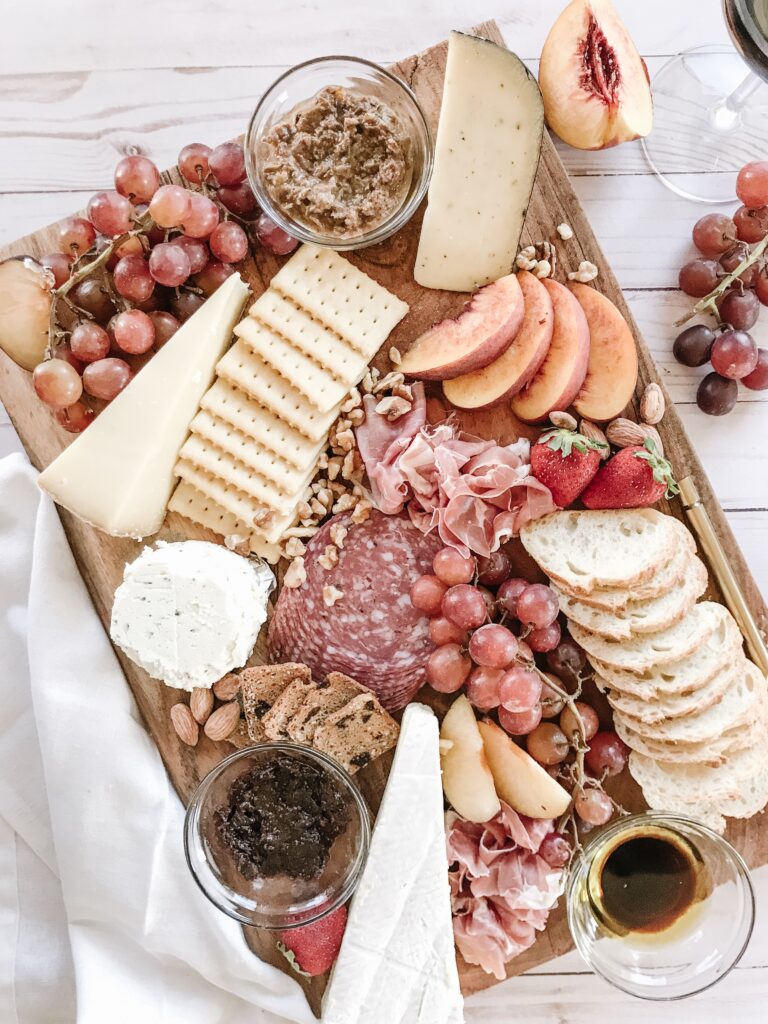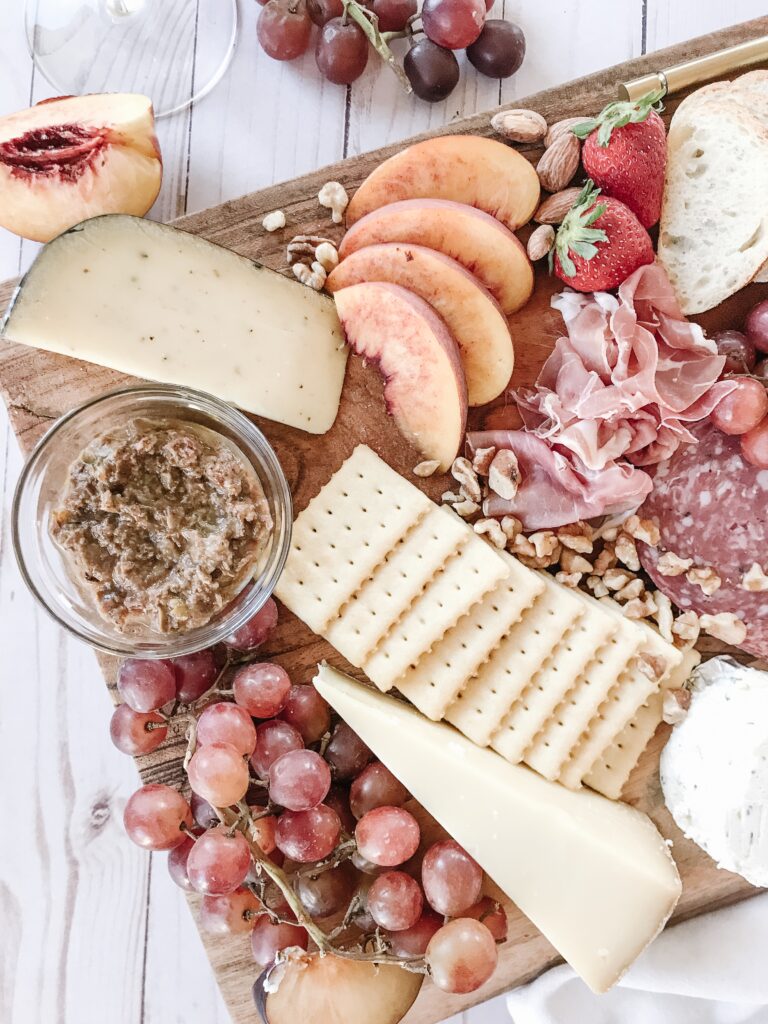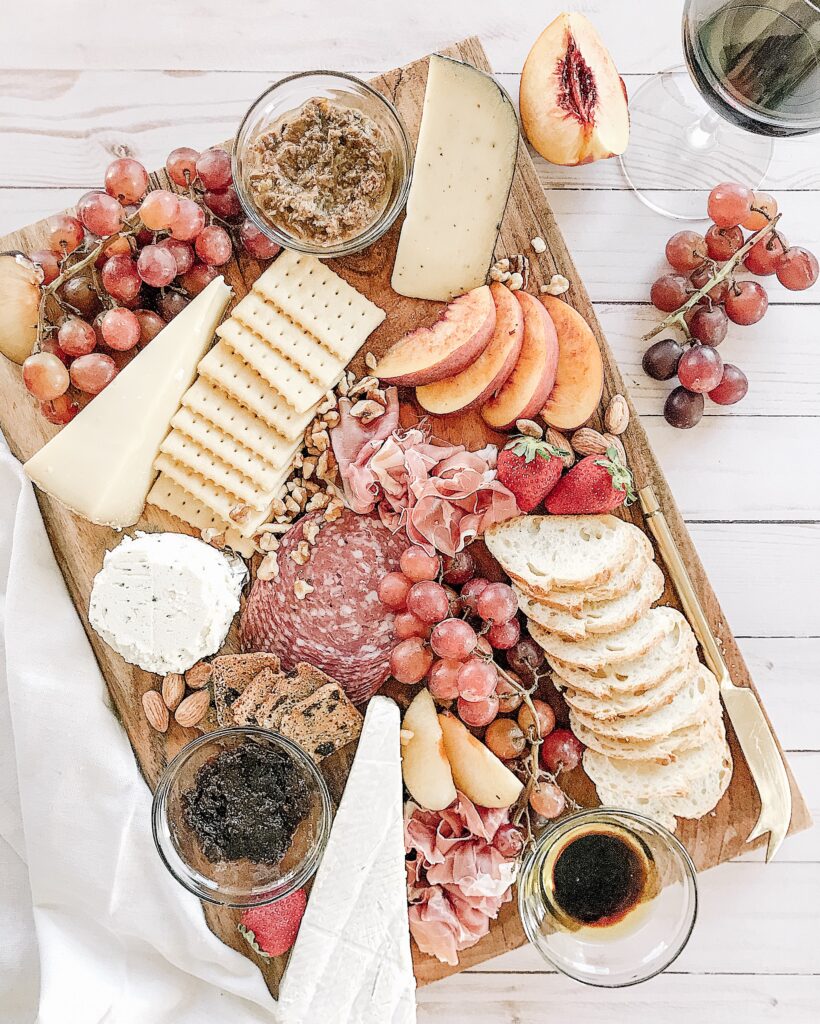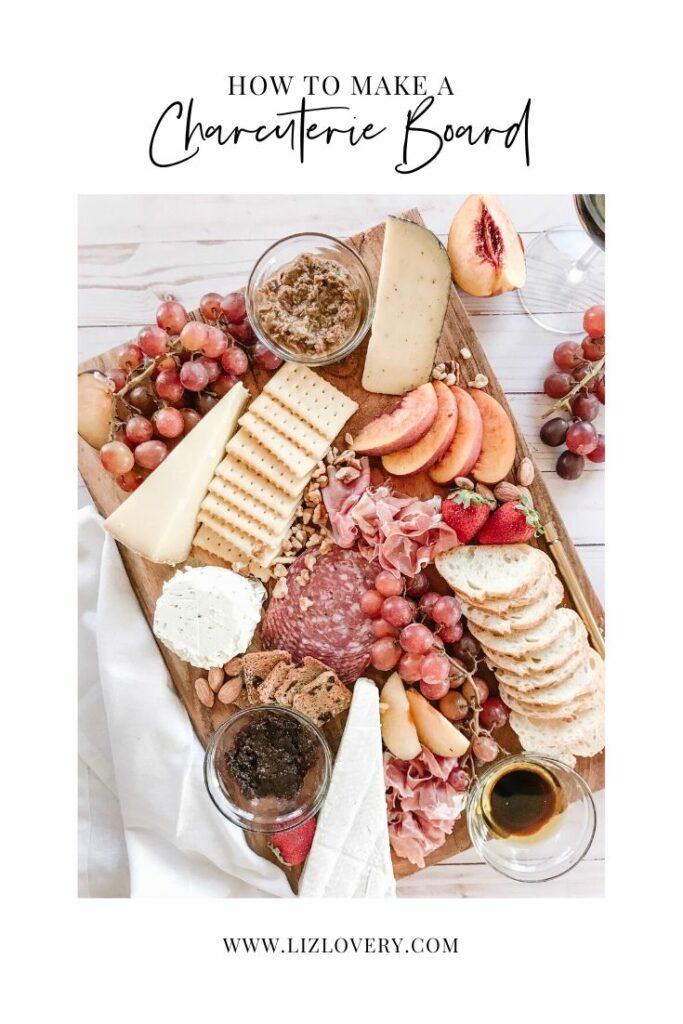Wanting to learn how to make a charcuterie board is one of those signs that you’ve reached the pinnacle of adulthood. It’s up there with scheduling your own appointments, folding your laundry the same day you wash them, and realizing that you’d rather stay in and watch Netflix on a Saturday night than go to a nightclub. A charcuterie board is sophisticated (at least it sounds sophisticated)—and making one will not only impress your guests next time you invite them over for dinner, but it will make you feel like the goddamn Queen of England. So, get your crowns ready because today I’m going to teach you how to make a charcuterie board and the seven essential elements it should include for the perfect spread.
What Is A Charcuterie Board?
Charcuterie, by definition, is a collection of cold cooked meats. The word charcuterie is a French term that translates to “cooked flesh”… a little morbid, I know, but the reality is that cold cuts are delicious—especially the kind that’s served on a charcuterie board. But, what is a charcuterie board? Well, the charcuterie itself is typically served on a wooden board, like a cutting board or cheese board, along with a variety of breads, cheeses, spreads, and fruits. It’s common, and expected, that you serve wine with a charcuterie board.



Best Types Of Charcuterie Boards
There are so many types of charcuterie boards out there and if you’re in the market for one, I highly recommend ordering one that’s larger than you anticipate you’ll need. I can’t tell you how many times I’ve purchased a charcuterie board only to realize it’s just NOT big enough for all the things I want to add to it. I don’t know about you, but for me, the presentation is KEY when it comes to making the perfect charcuterie board and I cringe and the thought of having all of my ingredients dispersed onto different plates or serving platters. I buy most of my charcuterie boards at Home Goods but it’s honestly hit or miss in that department. I’m linking a few charcuterie boards that are available on Amazon that look identical to the ones I have.






7 Charcuterie Board Essentials
There’s no right or wrong answer when it comes to what to put on a charcuterie board, but if you want to go above and beyond, it should include a variety of choices from seven different categories.
The best charcuterie boards should include:
1. Meat—You can’t have charcuterie without the meat, and it’s one of the most important elements of a good charcuterie board, in my opinion. The best meat to serve on a charcuterie board is some form of salami, I prefer peppered salami, and prosciutto. Prosciutto is an Italian dry-cured ham that is thinly sliced, which pairs perfectly with bread and cheese.
2. Cheese—Although it’s called a charcuterie board, the meats are often overshadowed by the cheeses. It’s easy to see why, though, cheese and wine are the perfect pair. But, when it comes to making your charcuterie board, having a variety of cheese is a must. I use 3-4 different types of cheeses that will almost always include a light and creamy cheese like Brie, a rich and flavorful cheese like a Truffle Parrano, a sharp and hard cheese like cheddar, and creamed and herb-infused cheese like a Gournay cheese.
3. Fresh fruit—Incorporating a variety of fresh fruits is important because it gives your palette a break from the salty meats and cheese. Meat and cheese tend to be rich in flavor and the fresh fruit brings a different element to the mix. I recommend using an assortment of in-season fruits, but again, you can’t go wrong here. There are a few fruits, however, that I feel taste amazing with wine and charcuterie: peaches, plums, grapes, strawberries, and figs. These fruits are also super colorful and add a little something extra to your charcuterie board.
4. Nuts—I love adding nuts to my charcuterie spread. You don’t need a lot but it does provide a warmer element to it and also adds a little extra protein. I usually will include whatever I have around the house and that’s usually almonds and walnuts but you can add whatever nuts you like.
5. Jams and spreads—Okay, this is another must for me. I think fig jam is the best jam you can serve with a charcuterie board. It isn’t too fruity and it tastes soooooo so good with brie cheese. I highly recommend it. Similarly, I think an olive tapenade is a game changer. Tapenade is a mixture of olives, oils, anchovies, capers, garlic, herbs, and lemon juice. It’s perfect for spreading on crackers. And you can’t forget about the honey! The honey adds just the right amount of sweetness and subtleness to the charcuterie without overpowering it. It might also be worth adding a little bit of balsamic vinegar and oil to the mix.
6. Bread/Crackers—In France, a traditional charcuterie board is served with bread, not crackers. And I follow this rule, to an extent. I always serve a French baguette, sliced, as well as two different types of crackers. I love a good ol’ butter cracker, especially with the tapenade. My go-to is the Club crackers by Keebler. I also like to add a dried fruit-infused cracker, like the Fig and Olive Crisps from Trader Joe’s. This one is a unique option for mixing and matching the cheese and fruit jams.
7. Wine—And last, but certainly not least, if you want to know how to make a charcuterie board, you absolutely can’t forget about the wine. A charcuterie board was intended to be eaten with wine so a good wine is crucial. This charcuterie board will go great with red or white wine, however, I feel the richness of some of the ingredients are incredible with a robust red, such as cabernet or a pinot noir. I think using lighter fruit jams, like apricot or strawberry will go great with white wine.



How To Arrange A Charcuterie Board
Here are some tips on how to arrange the food on your charcuterie board:
- Mix it up—When it comes to the arrangement of everything, its a good idea to distribute your food all over the board. For example, I don’t recommend putting all of your cheeses or fruits or spreads in one area. I like to break it up and have a good mix of everything spread across the board.
- Use smaller items to fill in gaps—Use the nuts and fruits to fill in any large gaps from bigger items. This not only looks good, but it also encourages your guests to try more items on the board.
- Don’t put everything on at once—Sometimes its a good idea to introduce things onto the charcuterie board in waves, or in smaller increments. Charcuterie can be filling, and one of the best parts about enjoying a charcuterie board is just that, it’s enjoying! Take your time and surprise your guests with more options as the night goes on.



Charcuterie Board Shopping List
This is everything you will need to make the perfect charcuterie board.
- Peppered salami
- Prosciutto
- Truffle cheese wedge (I buy Truffle Parrano)
- Sharp, hard cheese wedge (I buy Murray’s Maxx Extra Cheddar)
- Creamy, light cheese wedge (I buy Brie)
- Soft, creamed herbed Gournay cheese (I buy Boursin)
- Fresh peaches
- Fresh plums
- Grapes
- Fresh strawberries
- Fresh figs
- Roasted almonds
- Walnuts
- Fig jam
- Olive tapenade
- Honey
- Balsamic vinegar & oil
- French baguette
- Club crackers
- Fig and olive crisps
- Red or white white, or both!



